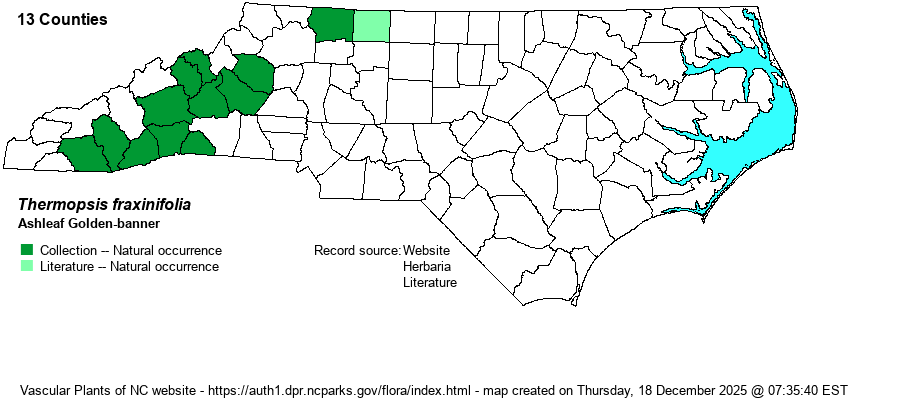| Author | (Nuttall) M.A. Curtis | |
| Distribution | Present over much of the Mountains, though mostly close to the Blue Ridge Escarpment and not farther west toward TN (only two records for TN border counties -- Mitchell and Yancey). Also ranges eastward into Piedmont foothill ranges, such as the Sauratown Mountains and the South Mountains. Ranges east to Stokes, Caldwell, and Burke counties.
This species has a small range centered in the southern Appalachians. It occurs across western NC and eastern TN, and then south only to northern GA. It is known from only four states -- NC, TN, SC, and GA.
| |
| Abundance | Rare to locally uncommon in the Blue Ridge Escarpment area, mainly at lower elevations in the central and southern Mountains. Rare and quite local into the western Piedmont. This is a State Special Concern species. The State Rank is S2S3. | |
| Habitat | This is a species mostly of rocky woods, typically where mesic to somewhat dry, and shaded or mostly shaded. Soils where it occurs are probably acidic, though it is not considered a plant of overly xeric, acidic soils. | |
| Phenology | Blooms from late May into July; fruits form July to October. | |
| Identification | The three Thermopsis species look quite similar vegetatively to a number of Baptisia species; they are easily separated by flower color -- yellow in all Thermopsis species and non-yellow for Baptisia species within the range of Thermopsis in NC (except for the very small-leaved B. tinctoria). Also, Thermopsis plants have laterally flattened pods versus inflated (rounded) pods in Baptisia. T. fraxinifolia is an erect and mostly smooth plant that grows to about 2 feet tall, with scattered but large leaves, and normally a few branches, so as to be as wide or wider in girth than tall. The 3 leaflets are elliptic to obovate, to a bit rhombic, and about 2.5 inches long and about 1 inch wide. The flower clusters tend to be spreading or even drooping, coming off of leaf axils or at the ends of the stem; the stalks are quite long (beyond the ends of the leaflets), and the loose racemes of large yellow flowers cover the outer 4-6 inches of the stalk. Each flower is about 2/3-inch long. The most similar species is T. mollis, which is a shorter plant (usually not much taller than 1 foot high) that grows in colonies and has terminal flower clusters that are erect or at least ascending (as opposed to horizontal or otherwise drooping). T. villosa is a much taller and erect plant, often 3-5 feet tall or more, essentially without branches, and a strongly erect terminal raceme. This is a strikingly beautiful plant when in bloom, owing to the long and often drooping clusters of bright yellow flowers, especially growing in such dry and rocky places where few other showy herbs might be found. Sadly, it is a rather rare species, and you might not be able to discover a population on your own, and thus may need to visit known sites in protected natural areas. | |
| Taxonomic Comments | Some references lump this species with T. mollis, where named as T. mollis var. fraxinifolia. However, botanists who are familiar with both species know that this is simply incorrect; as Weakley (2018) says "T. fraxinifolia tends to have thinner stems than T. mollis, to average taller, and to have the inflorescence generally arching to reclining (vs. erect to sometimes arching). The phenologic separation (peak flowering times separated by about 6-7 weeks, generally with a 2 week period between the last flowering of T. mollis and the first flowering of T. fraxinifolia) provides strong support to the recognition of T. fraxinifolia and T. mollis at the species level."
| |
| Other Common Name(s) | Ash-leaved Bush-pea | |
| State Rank | S2S3 | |
| Global Rank | G3? | |
| State Status | SC-V | |
| US Status | | |
| USACE-agcp | | |
| USACE-emp | | |

